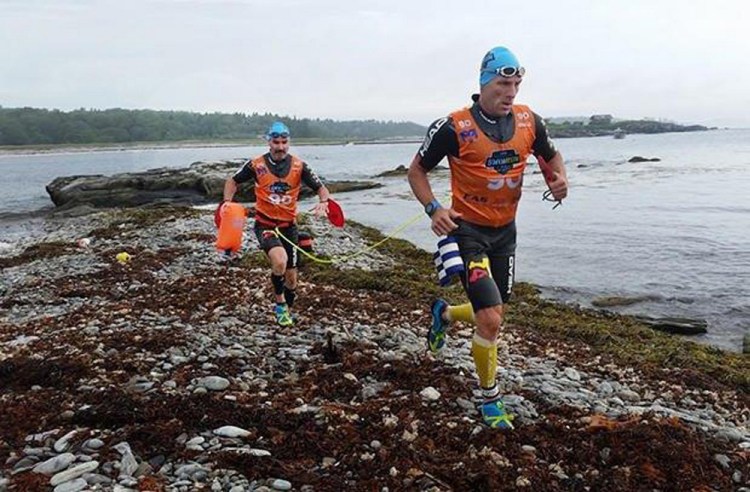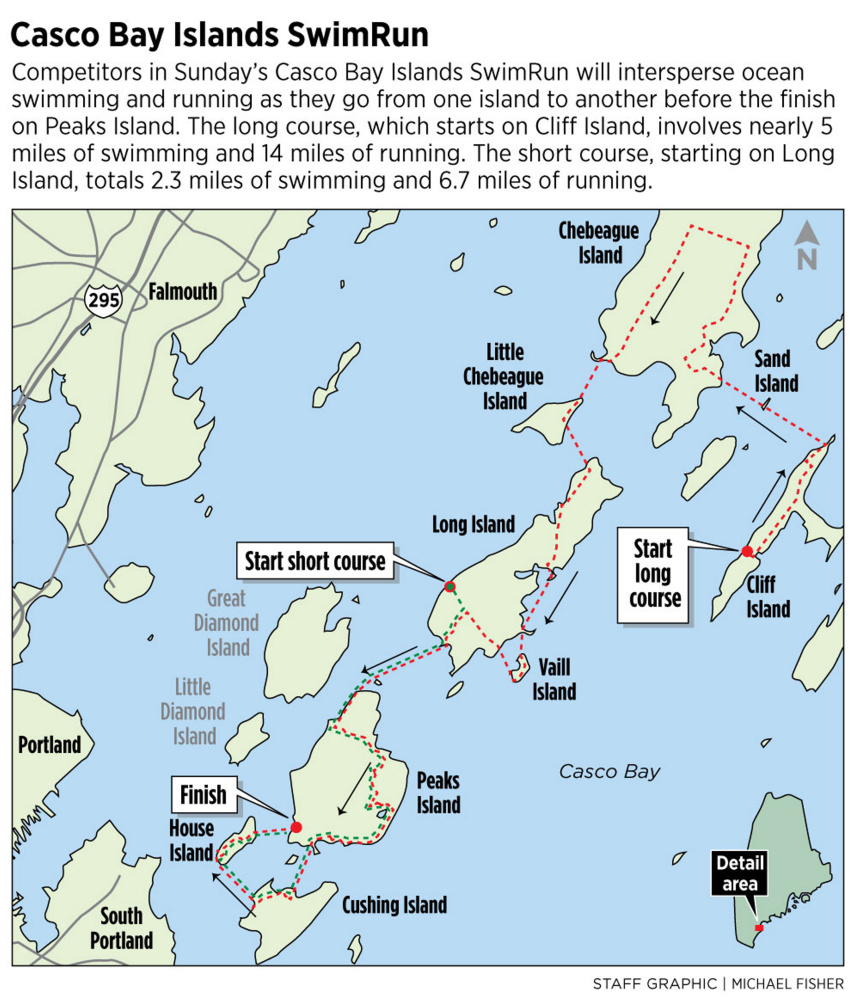Jeff Small of Scarborough took his boat out Tuesday afternoon, puttering about the islands of Casco Bay, considering tides and currents and what conditions might be like Sunday morning.
That’s when Small and his sister, Angela Bancroft, plan to swim between and run over nine islands in the second annual Casco Bay Islands SwimRun competition. They’ll cover nearly 5 miles in the water and another 14 on land, starting on Cliff Island and finishing on Peaks.
“It’s something different,” said Small, 44, who raced with Zack Priest of Cumberland last year in the men’s division. “I think I was a little more excited about it than he was.”
Small and Bancroft are triathletes who grew up as competitive swimmers in Cape Elizabeth. Bancroft, who lives in Paris and has three kids in the Oxford Hills school system, couldn’t take part in last year’s inaugural SwimRun race because of an Ironman Triathlon race in Mont-Tremblant, Quebec.
“This is a whole different type of challenge,” said Bancroft, 47. “It’s a completely different type of racing, yet still hard, and to do something like that with my brother should be pretty fun.”
The idea of racing through an archipelago sprang from a bar bet in Sweden in 2002. Four years later, two guys turned the thing into a commercial race and now there’s an entire series, mainly in Europe but spreading. Casco Bay hosts the only island-to-island event in North America, although there are swim/run races centered around lakes.
Jeff Cole, a triathlete from Kennebunk, read about Ötillö (Swedish for “island to island”) in Outside magazine and checked out video on YouTube. He called a friend in Texas who is passionate about endurance sports, and it turned out the friend already had competed in the Ötillö world championship race in Stockholm.
“We need to bring this to North America,” Cole told his buddy, Lars Finanger, and they became co-directors of the Casco Bay race, which involved about four miles of swimming and 10 of scampering over islands. They chose the Travis Mills Foundation, which benefits combat-injured veterans, as their charity and donated $10,000 last August.
“We’re hoping we can do more this year,” said Cole, who makes his living as an insurance broker.
The feedback they received from the inaugural race?
Make it longer.
“So we have,” Cole said. “Within that long course race we’ve embedded the short course to attract people who might want to give it a try.”
Last year’s race included 122 teams of two in three divisions (men’s, women’s and mixed). Entry fees this year were $750 and $550 per team, and Cole expects about 85 pairs for each race.
The long course, which starts on Cliff Island, involves nearly 5 miles of swimming and 14 miles of running. The short course, starting on Long Island, totals 2.3 miles of swimming and 6.7 miles of running.
Wetsuits, emergency whistles and compasses are mandatory. You can use a variety of gear, including hand paddles, swim fins and small flotation devices called “pull buoys” for your legs, but if you start with it you must finish with it.
Teammates must remain within 10 meters of each other at all times, so they use tethers about 10 feet long to remain together. They can unclip while they run.
“It’s unlike any other type of endurance competition we’re accustomed to seeing here in North America,” Cole said. “There are interesting social dynamics. It’s not uncommon where one of them wants to bail out and the other one doesn’t, and they’ve got to work that out.”
The longest swim is close to a mile across Hussey Sound from Long Island to Peaks. The longest run stretches more than 4 miles on Chebeague Island. While mapping the course last weekend, Cole came across youngsters who plan to set up a lemonade stand. He advised athletes to stick a few dollar bills in their wet suits “because a glass of lemonade is going to taste mighty good.”
Cole worked with private landowners and land trusts as well as island rescue personnel and the Coast Guard to put the race together, and is grateful to have their blessing.
“We emphasize to no small degree to our athletes,” he said, “enjoy the natural environment but leave it in better shape than you found it.”
Along the way are eight aid stations (five on the shorter course) for water and refueling. The longer course includes two checkpoints, at Fowlers Beach on Long Island and Torrington Point on Peaks. Competitors who haven’t reached them by a certain time are not allowed to continue.
John Stevens, who grew up on Little Diamond Island, and Matt Hurley, who grew up in Belfast, are the defending men’s division champions, having completed the course in roughly 31/2 hours.
Last month they placed second and third in the Peaks to Portland Swim, separated by fewer than a second.
“We’re pretty well suited to doing this together,” said Stevens, 38. “We’re definitely a little more aware of what’s going to be thrown at us, but there’s so many factors – weather, tides, current – that we really won’t know what we’re up against until we get out there.”
Nate Stevens, John’s brother, is competing in the Short Course race. Stevens and Hurley, 33, will be doing the Long Course.
Last year Stevens used paddles for the swim and Hurley did not. This year Stevens plans to add the pull buoy. They also will wear wet suits with zippers in front instead of the back so they can be opened up for the running portions.
“We found we overheated,” Stevens said.
Even with his lifelong knowledge of the islands, Stevens said he and Hurley got lost a few times in last year’s race and had to backtrack. Running through the Peaks Island Land Preserve can be “incredibly tricky,” he said.
Spectator ferries from Casco Bay Lines depart at 5:30 and 5:45 Sunday morning for the 7 a.m. starts. The Long Course begins on Cliff Island the Short Course on Long Island. They share a finish line on Peaks, near the ferry landing, so anyone on the later-morning ferries to Peaks can catch plenty of action.
When Stevens mentions the race to anyone, the reaction falls somewhere between “a kind of disbelief that something like this exists to shock,” he said.
“If you talk to triathletes, they say, ‘Wow, that’s awesome, how do I get into that?’ If you talk to my mother, it’s ‘You’re crazy.’ ”
Correction: This story was updated at 9:20 a.m. on Aug. 9, 2017 to correct the term “pull buoy.”
Send questions/comments to the editors.





Success. Please wait for the page to reload. If the page does not reload within 5 seconds, please refresh the page.
Enter your email and password to access comments.
Hi, to comment on stories you must . This profile is in addition to your subscription and website login.
Already have a commenting profile? .
Invalid username/password.
Please check your email to confirm and complete your registration.
Only subscribers are eligible to post comments. Please subscribe or login first for digital access. Here’s why.
Use the form below to reset your password. When you've submitted your account email, we will send an email with a reset code.